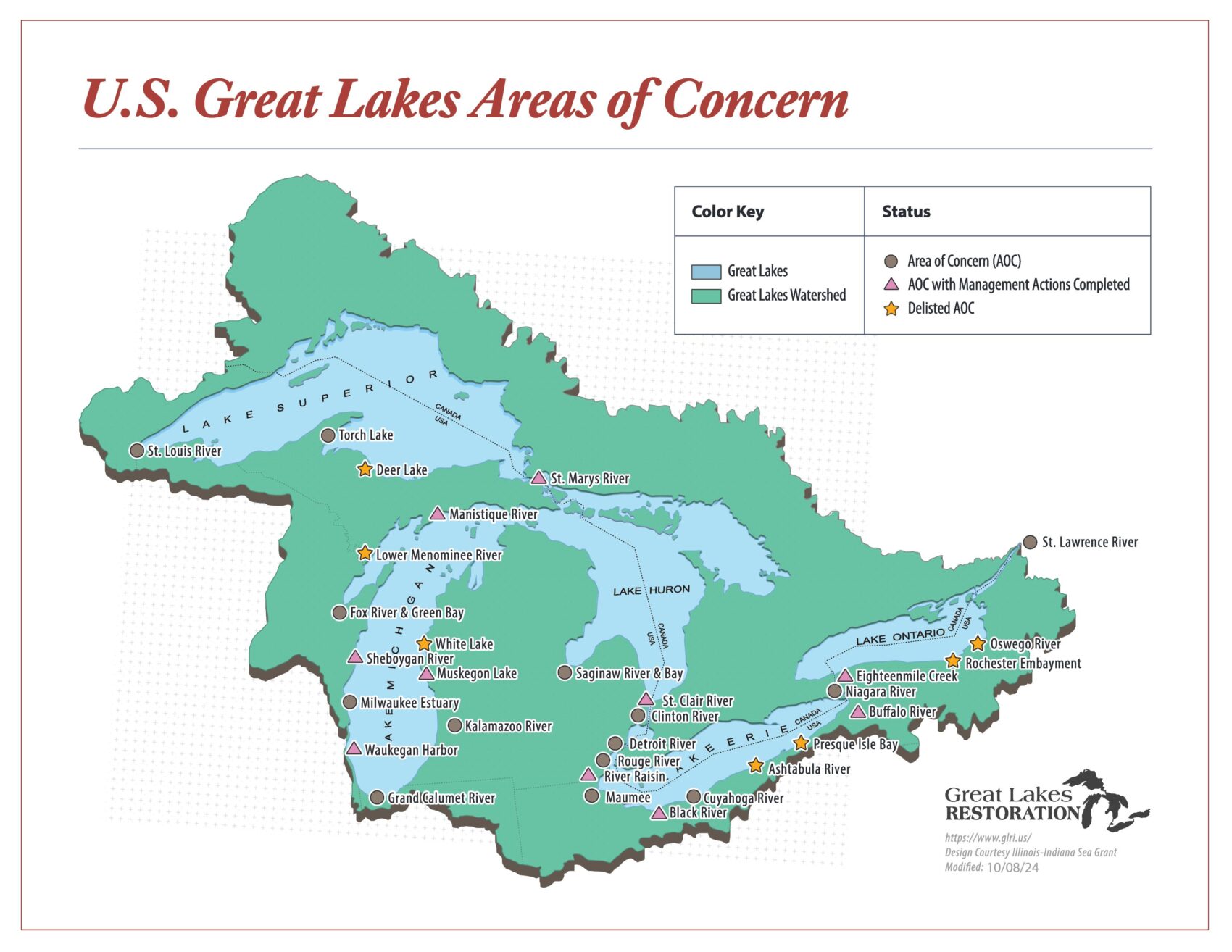Habitat Restoration in Great Lakes Areas of Concern
NOAA-GLC Regional Habitat Restoration PartnershipAbout Habitat Restoration in AOCs
The Great Lakes Commission (GLC) and the National Oceanic and Atmospheric Administration (NOAA) are leading efforts to restore several Great Lakes Areas of Concern (AOCs) — the worst “toxic hotspots” in the region. The GLC implements restoration work through a NOAA Regional Partnership, a unique funding mechanism that allows key projects to receive critical funding while maintaining necessary flexibility for changing needs and administrative and communications support.
In recognition of the GLC’s longstanding commitment to restoring AOCs, it has been awarded five regional habitat restoration partnerships since 2008, with the potential of up to $100 million being directed to key sites across the basin. The partnerships are aligned and coordinated with ongoing efforts of federal and state agencies to implement other restoration projects in AOCs, and are expected to culminate in formal removal, or de-listing. These projects have immense environmental and economic benefits, and are helping to enhance quality of life for citizens across the basin.
As of 2024, The NOAA-GLC partnerships have totaled more than $70 million in funding, and include 45 multi-phase projects in eight AOCs with fifteen local project partners.
.
Habitat Restoration Project Overviews

Areas of Concern (AOCs) are watersheds, or portions of watersheds, along the Great Lakes suffering from degraded environmental conditions stemming from historic and ongoing pollution. They were designated under the U.S.-Canada Great Lakes Water Quality Agreement based on criteria that include drinking water restrictions, loss of fish and wildlife habitat and beach closures.
NOAA Regional Partnerships support fish and wildlife habitat restoration efforts in AOCs by designing and implementing high priority projects that are identified by the U.S. Environmental Protection Agency, NOAA, the states, and local AOC leaders. The partnerships are aligned and coordinated with ongoing efforts of federal and state agencies to implement other restoration projects in AOCs, and will eventually culminate in formal removal, or de-listing. Funding through the Great Lakes Restoration Initiative (GLRI) and the development of the GLRI Action Plan has significantly expedited restoration in AOCs and provides funding for the NOAA-GLC partnerships.
The Great Lakes Commission has been engaged in Regional Partnerships with NOAA since 2008 to implement design, construction and monitoring of key habitat restoration projects. Partnerships typically last three to five years. GLC has completed projects in the Muskegon Lake, St. Marys River, and Buffalo River AOCs and recently wrapped up projects funded under a 2016 partnership in the Muskegon Lake, Clinton River, Cuyahoga River, and Maumee AOCs. A partnership established in 2019 is funding six restoration projects in the Muskegon Lake, Cuyahoga River, and Maumee AOCs, the engineering and design and phase 1 construction of a project in the Niagara River AOC, and adds a unique restoration project located in a priority coastal area along the Lake Ontario shoreline. A new 2023 Partnership is funding additional phases of a restoration project in the Maumee AOC, the design and implementation of a new project in the Maumee AOC, and the final construction phase of a restoration project in the Niagara River AOC.
To implement this work, the Great Lakes Commission offers a centralized, core team that is augmented by local implementation partners and research institutions to help steward AOCs into social, economic and ecological sustainability.
Project Partners
National Oceanic and Atmospheric Administration
Funding
Funding is provided by the Great Lakes Restoration Initiative and U.S. Environmental Protection Agency through a Regional Partnership between the National Oceanic and Atmospheric Administration and the Great Lakes Commission (GLC). In 2013, GLC was awarded approximately $30 million through this Partnership to work with partners to implement habitat restoration in Areas of Concern across the Great Lakes Basin. An additional $40 million was made available in 2016 and $12.5 million was made available in 2019 to continue restoration activities under two other Partnerships.
For More Information
Jill Estrada
Project Manager
[email protected]
Sign up for our e-newsletter
Get the latest Great Lakes Commission news and events in your inbox!
Sign up for our e-newsletter
Get the latest Great Lakes Commission news and events in your inbox!
